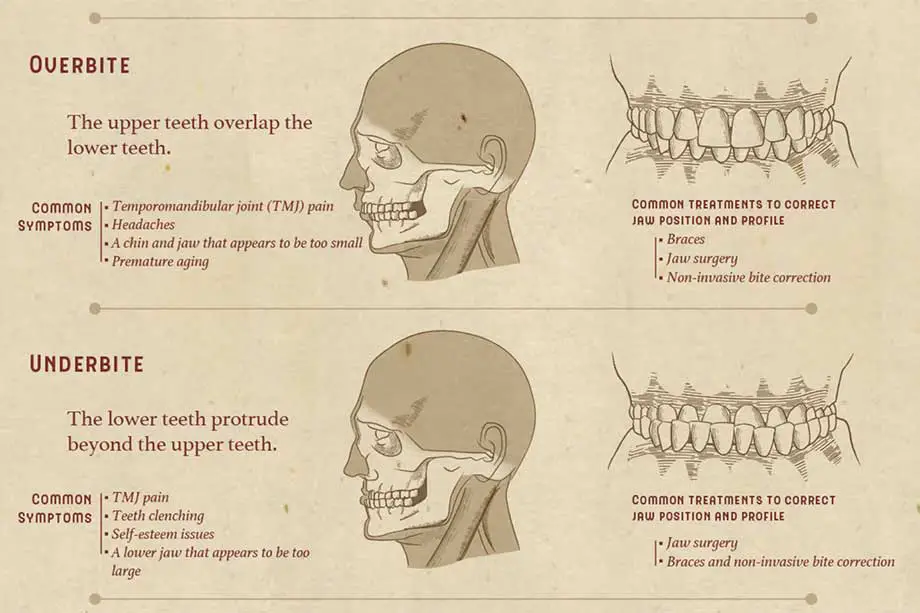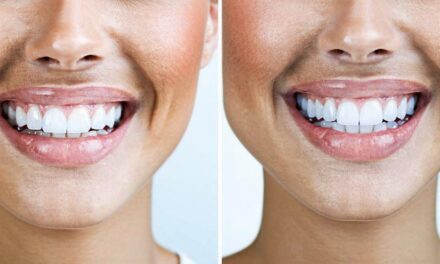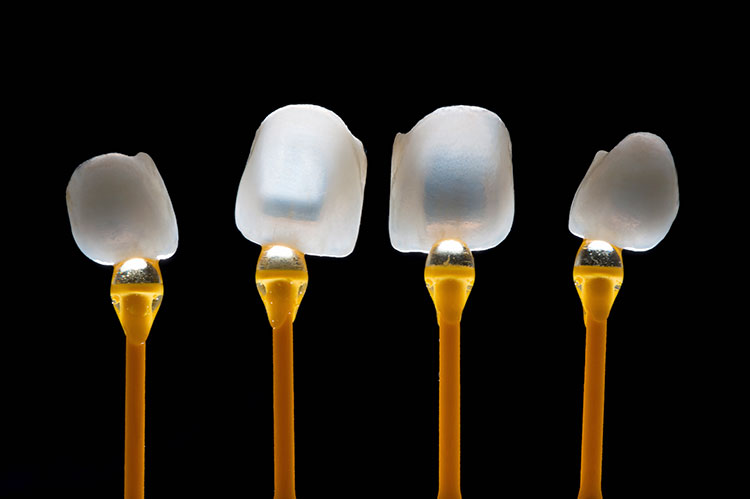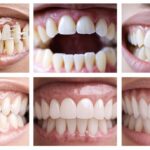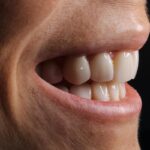Every time you look in the mirror, you see it. Your smile. But your smile isn’t making you smile. If something about your bite seems off, you probably have a malocclusion.
Bite issues are also referred to as malocclusions. A malocclusion occurs when teeth don’t properly align according to the National Institutes of Health (NIH). A normal bite finds the upper teeth just slightly fitting over the bottom teeth and the molar points sitting in the grooves of the opposite molar. Underbites and overbites are two types of bites. They each have certain causes while having noticeable differences.
Malocclusion and Types
According to the National Institutes of Health (NIH), a malocclusion results from failure of your teeth to align properly. Occlusion is how your teeth align; meaning, the way the upper and lower teeth fit together. This is more commonly referred to as your bite. A normal bite occurs when the upper teeth slightly fit over the lower teeth. And the molar points fit in the grooves of the opposite molar. The upper and lower teeth each serve protective purposes inside the mouth. The upper teeth protect against biting your cheeks and lips while the lower teeth safeguard the tongue.
Three Categories of Malocclusion; Class I, Class II, and Class III.
A Class I malocclusion is when the upper teeth slightly overlap the lower teeth. Despite that minor imperfection, a Class I malocclusion bite is considered normal. The only real drawback associated with a Class I is that the teeth tend to be crowded and crooked. This can make maintaining good oral care through brushing and flossing a challenge. And that can lead to dental problems down the line.
A Class II malocclusion results from the upper teeth and jaw severely overlapping the lower teeth and jaw. This is known as a retrognathism. Or, more commonly referred to as an overbite.
A Class III malocclusion results from the lower jaw and teeth greatly protruding beyond the upper teeth and jaw. This is known as a prognathism. Or, more commonly referred to as an underbite.
Malocclusion Symptoms
For those suffering from one of the malocclusion classes, specifically Class II or Class III, there are a handful of symptoms that indicate you have a bite issue according to Healthline. Misaligned teeth is a common one. A person’s facial appearance might appear altered. Frequently biting the tongue or inner cheeks and discomfort when biting and chewing are common traits that signal a bite problem exists. You also might develop speech issues, including a lisp. Lastly, you could regularly breathe through your mouth as opposed to your nose.
Overbite
An overbite is a Class 2 malocclusion known as a retrognathism according to the NIH. Just the opposite of a prognathism, an overbite result from the upper jaw and teeth severely extending beyond the bottom jaw and teeth.
Similar to an underbite, an overbite can be hereditary according to Colgate. But poor genetics isn’t the only cause and many of them result from childhood habits. Those include thumb sucking, tongue thrusting, and extended bottle usage note Colgate. A child’s jaw can also develop incorrectly. In the case of an overbite, the upper jaw will be overdeveloped while the lower jaw will be underdeveloped. Habits more common in adults, such as nail-biting and chewing pencil eraser heads, can also lead to an overbite.
Having an overbite is quite common according to DentalHealthMed.com. Some people don’t even realize they have an overbite malocclusion since it isn’t serious enough to warrant dental intervention.
Overbites can be skeletal or dental. A skeletal overbite tends to refer to the upper jaw severely protruding beyond the lower jaw. A dental overbite is tooth-related. The realignment of the jaw and non-invasive bite correction can correct this.
Three main causes of overbites are hereditary conditions, jaw bone abnormalities, and poor chewing habits. Leaving an overbite untreated can cause oral health issues. Some of these include jaw pain, enamel loss, speech issues, and poor self-esteem. Chances of developing tooth decay and periodontal disease also increase.
Underbite
An underbite is a Class 3 malocclusion notes the NIH. It is also known as a prognathism. An underbite results from the lower jaw jutting out. This causes the bottom teeth and lower jaw to overlap the upper teeth and jaw.
Underbites tend to be hereditary. If you are born with one, you’ll probably have a larger lower jaw or smaller upper jaw. Supporting the genetics theory is the fact that Asians tend to have a higher percentage of underbites than the rest of the population. And an underbite is far less common than an overbite. They affect a mere 5-10 percent of the population.
An underbite can develop from non-hereditary factors too. Tongue thrusting causes the lower jaw to push forward in early childhood as the tongue rests on the lower front teeth. Children who have allergies and nasal issues opt to breathe through their mouths. Mouth breathing positions the tongue in a similar manner as tongue thrusting. That can also lead to an underbite. Thumb sucking, jaw bone development issues, and chewing habits are additional underbites causes according to DentalHealthMed.com (DHM).
Developing an underbite is far less common than having an overbite notes DentalHealthMed.com. Underbites occur in only five to ten percent of the world’s population. Folks of Asian descent are more prone to having a Class III malocclusion.
Similar to an overbite, an underbite is caused by hereditary conditions, jaw bone abnormalities, and poor chewing habits. Thumb-sucking as a baby can also lead to an underbite.
Not correcting an underbite will lead to many of the same oral health issues as an untreated overbite does. An untreated underbite also leads to abnormal tooth alignment.
If you think you suffer from a faulty bite, schedule a dental consultation. Your dentist will examine you for a malocclusion, determine the type, and discuss potential treatments, including non-surgical options.
The views expressed by the author do not necessarily reflect our opinion.

